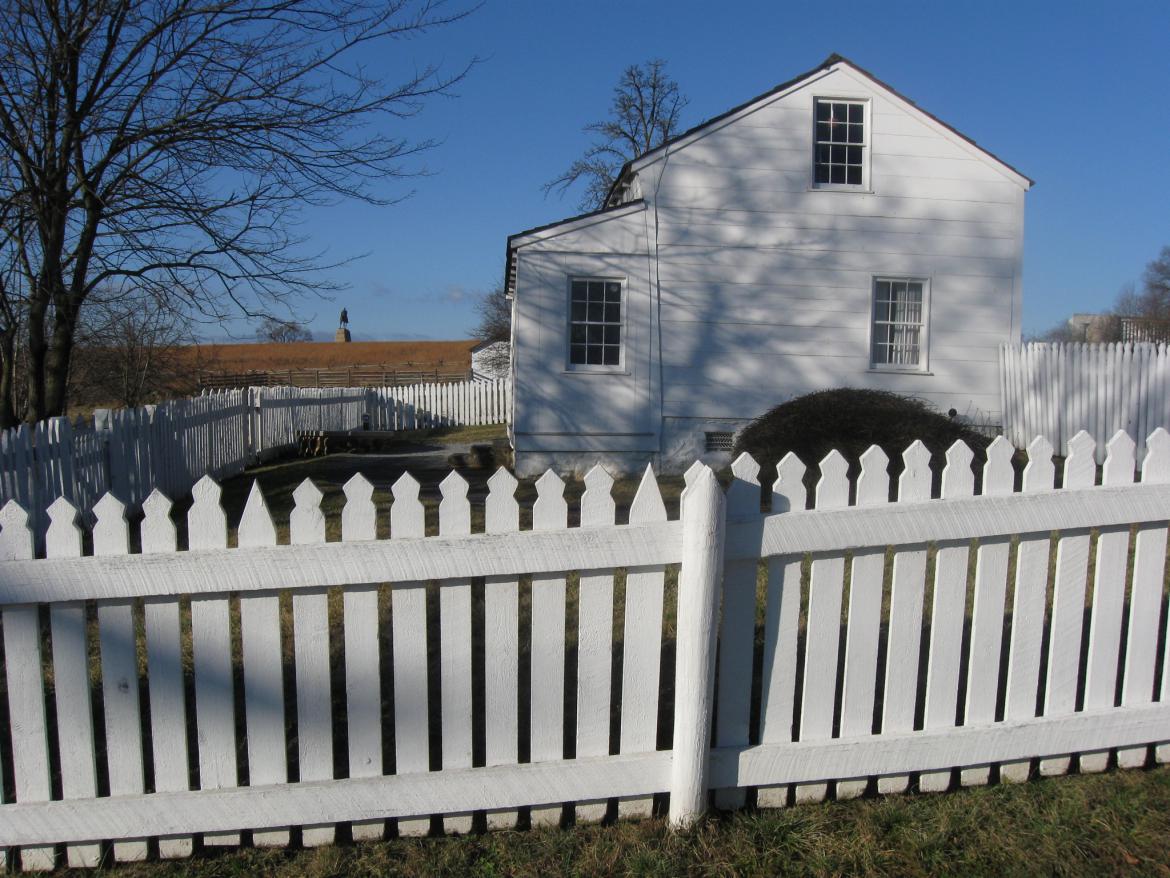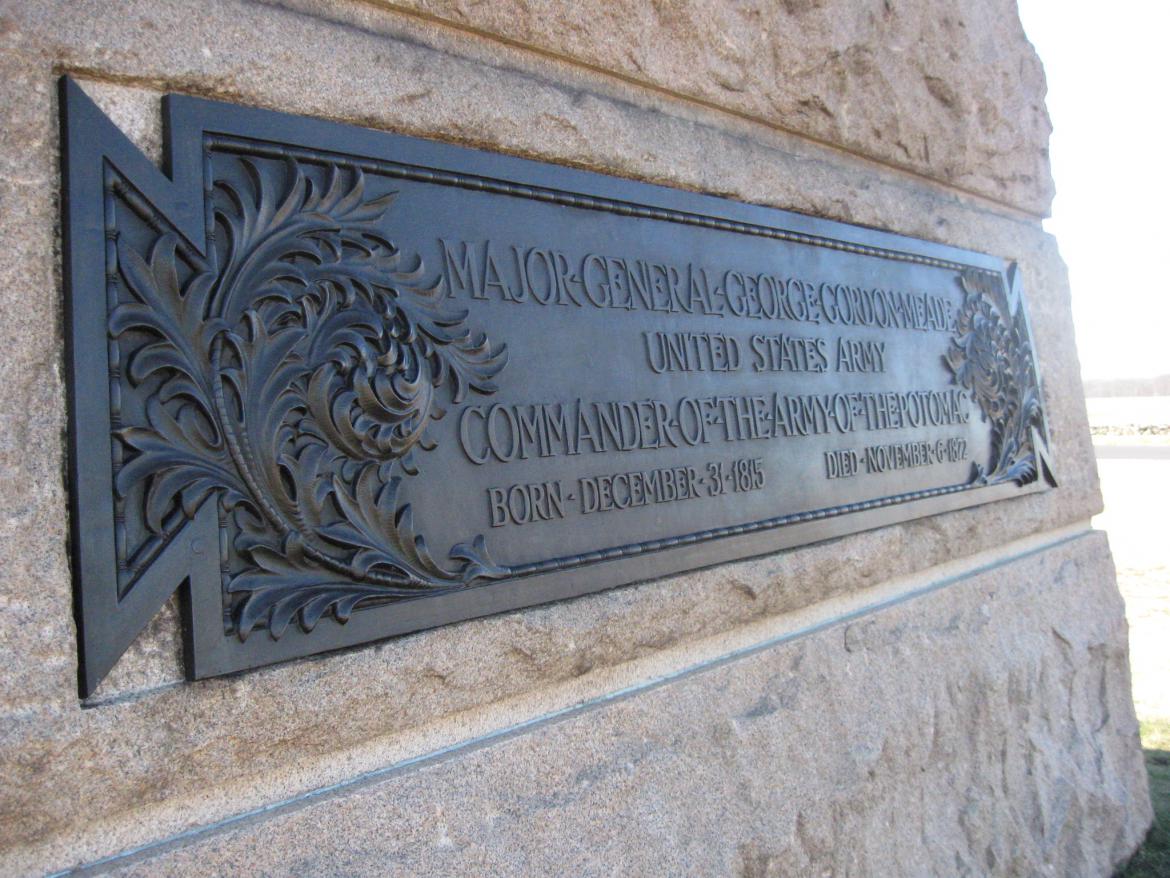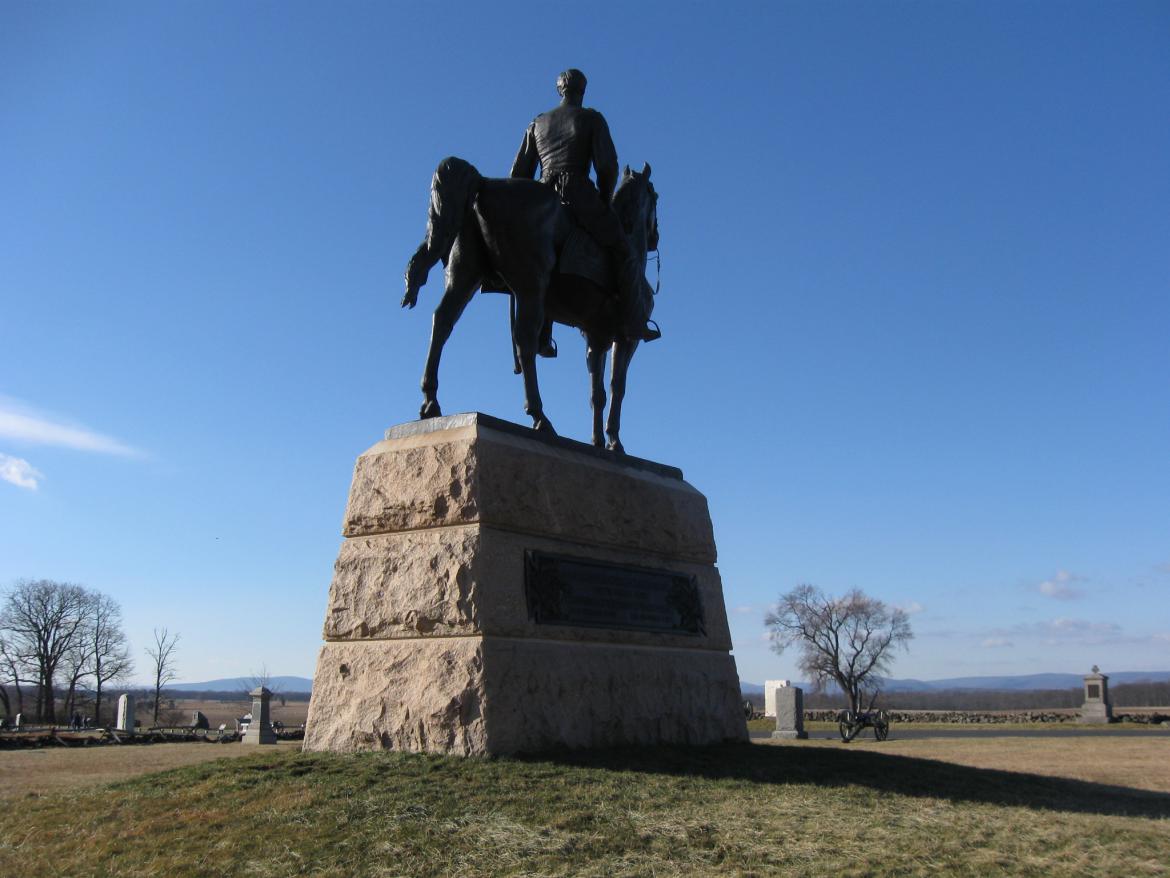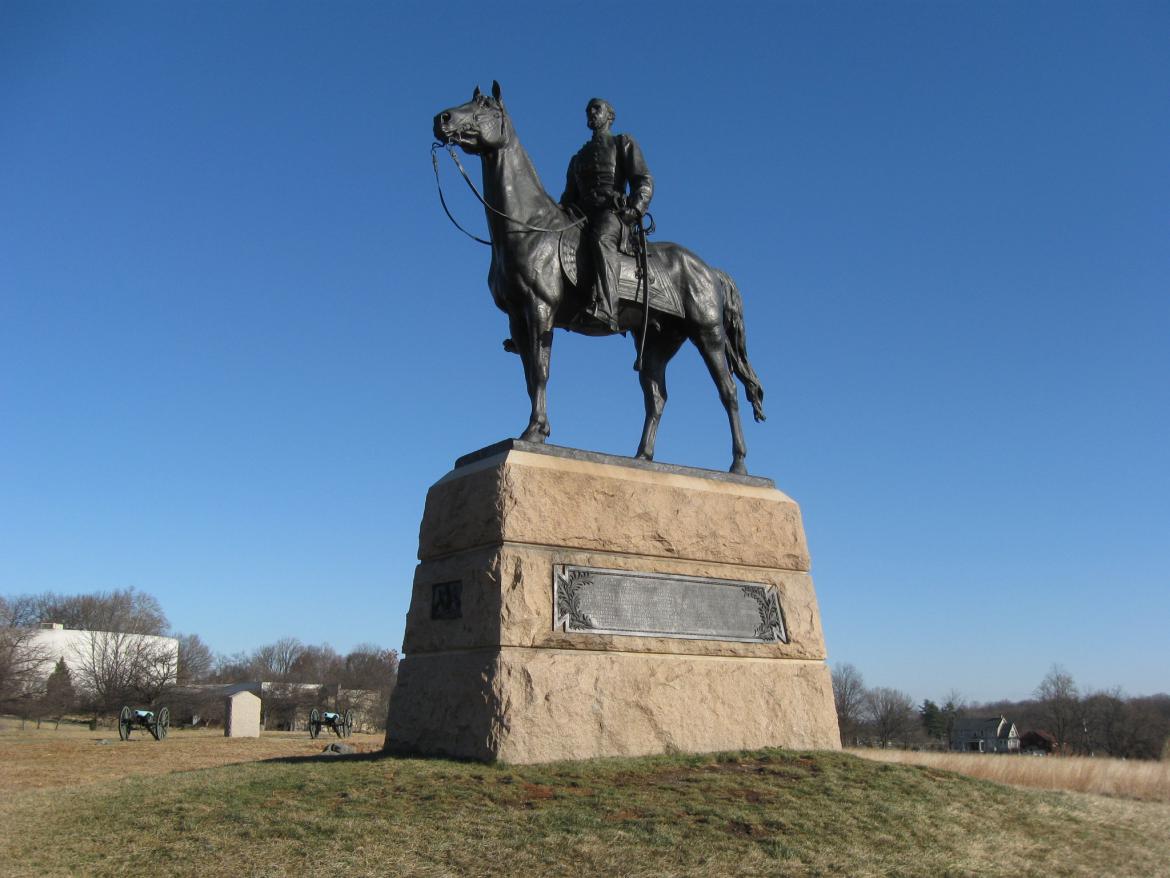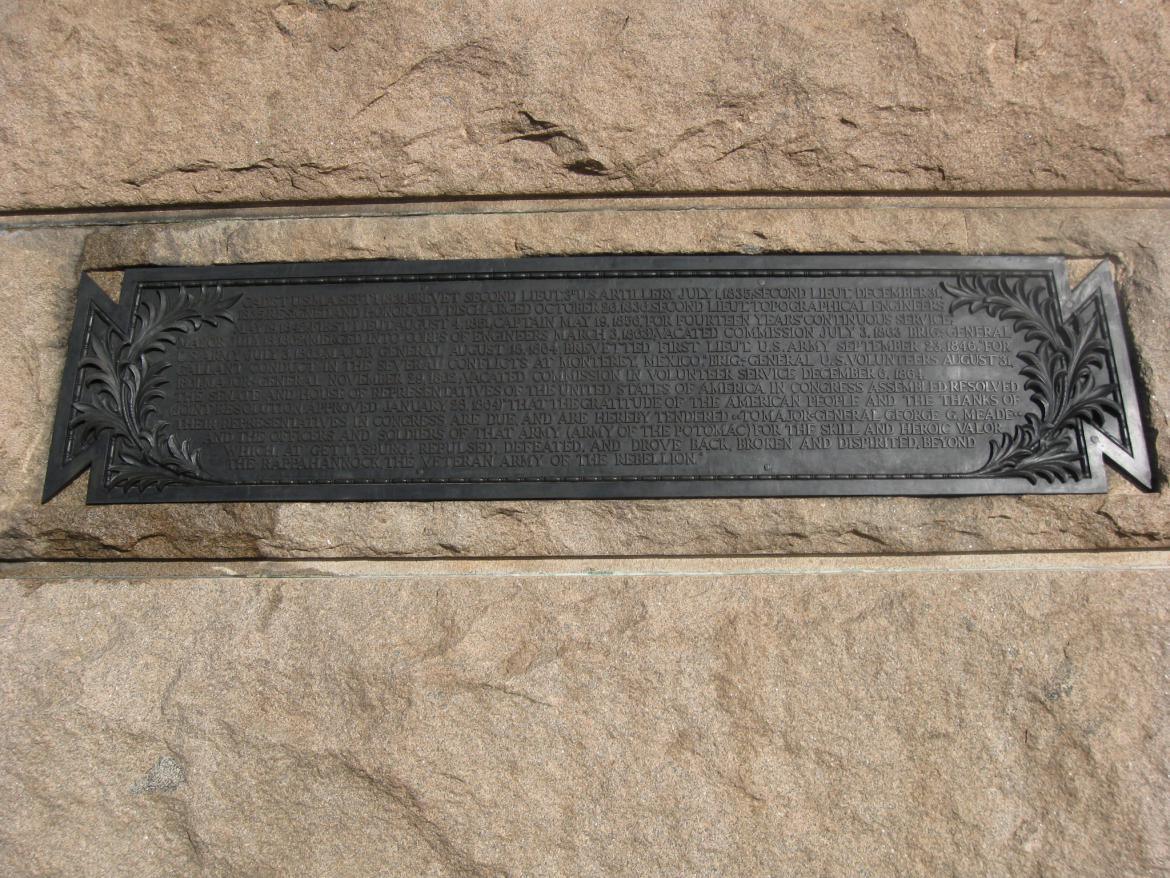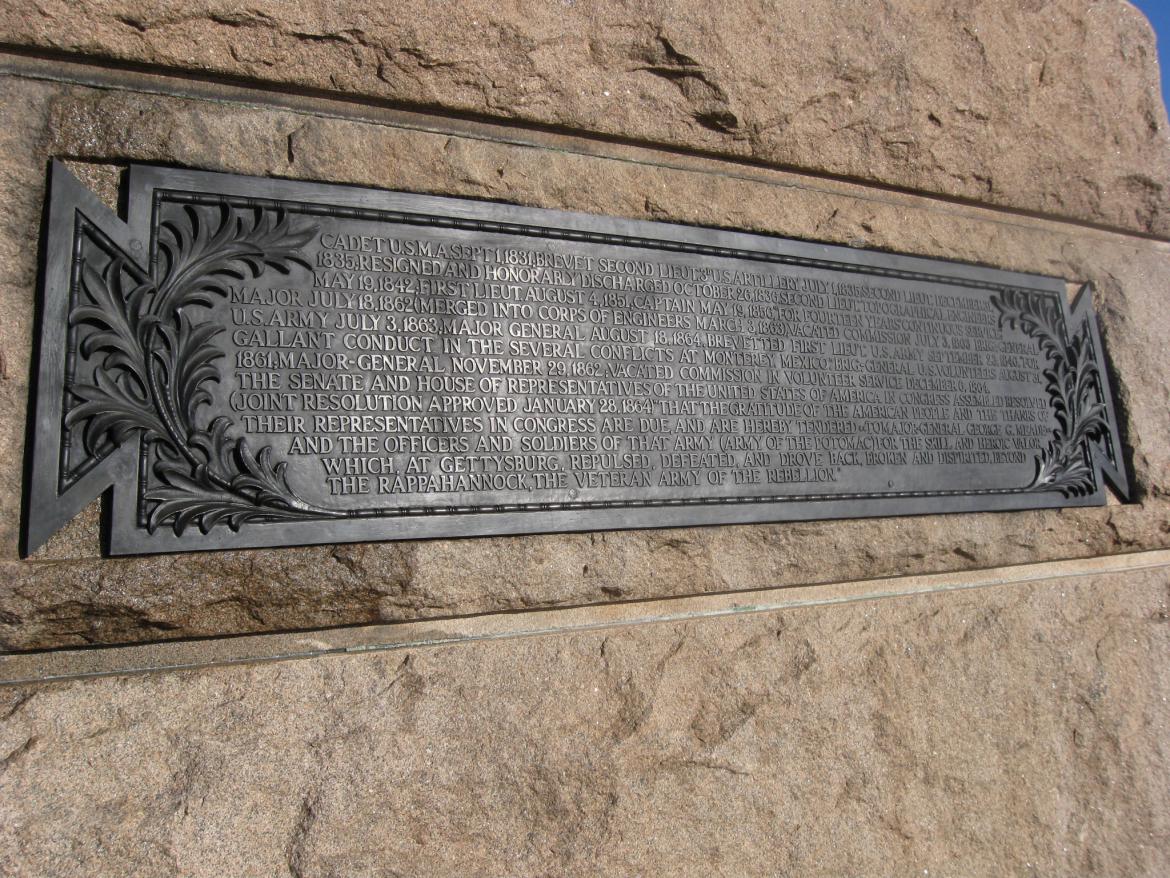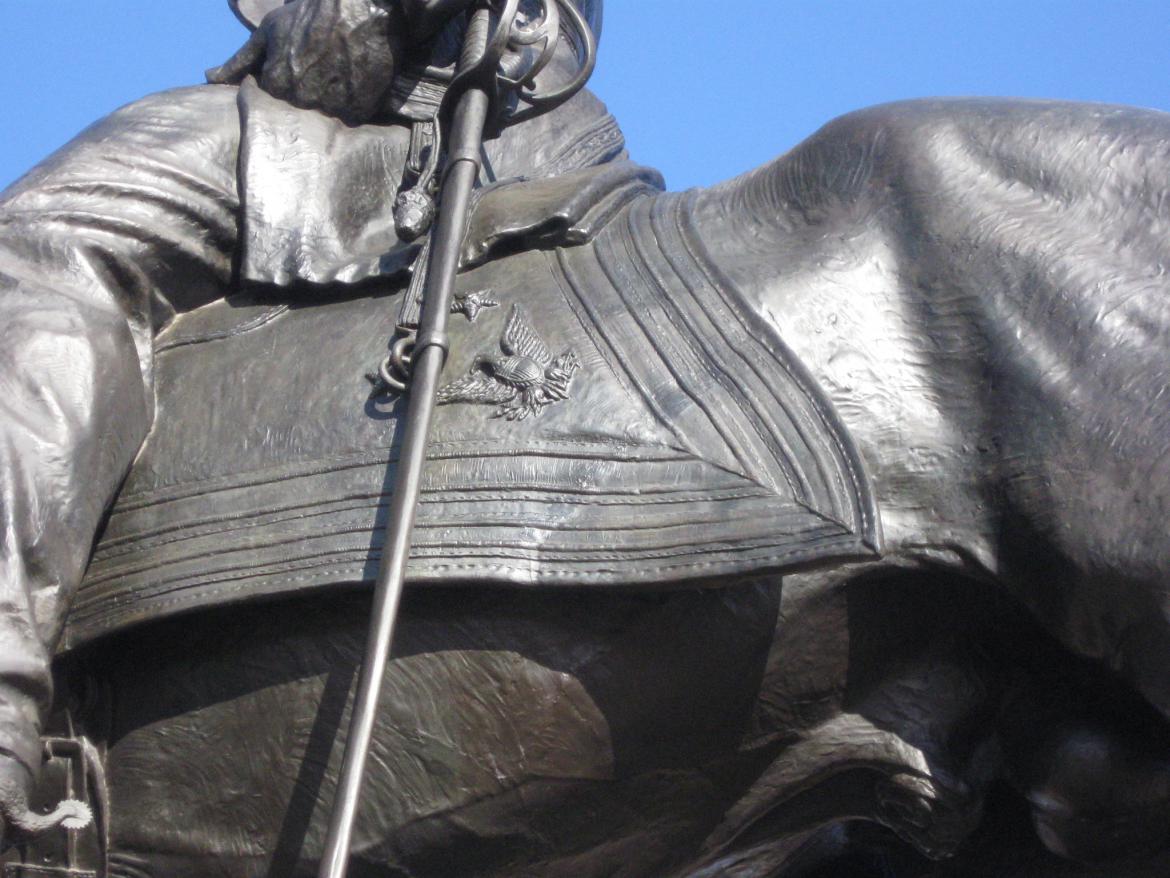George Gordon Meade was born 193 years ago today, December 31, 1815, in Cadiz, Spain. Cadiz is located on the southern coast of Spain, approximately 50 miles northwest of Gibraltar. It has been the home of the Spanish Navy since the 1700s. This view was taken facing north at approximately 10:00 AM on Thursday, December 25, 2008.
United States Major General George Gordon Meade was born on this date in 1815 and married on this date in 1840. Meade is one of the most underrated officers of the American Civil War. The Gettysburg Campaign helped to raise, and at the same time lower, his reputation as an aggressive, fighting General. We took pictures over a couple of days at three prominent George Meade locations at Gettysburg: his headquarters marker at the Lydia Leister House, his equestrian statue on Cemetery Ridge, and his statue on the Pennsylvania State Memorial.
The Lydia Leister House is located along the Taneytown Road on the east slope of Cemetery Ridge. The Meade Equestrian statue is on the top of the ridge in the left background. George Gordon Meade was the eighth of eleven children of Richard Worsam Meade and Margaret Coats Butler Meade. His father was a wealthy Philadelphia merchant serving in Spain as a naval agent for the U.S. government. This view was taken facing west at approximately 9:30 AM on Thursday, December 25, 2008.
Meade’s Headquarters Marker is the upturned artillery tube west of the Leister House. The Leister Barn is in the background. George Gordon Meade’s father was ruined financially because of his support of Spain in the Napoleonic Wars. The Meade’s returned to the United States in 1828 without little money when Richard Meade died in Washington, D.C. in June, 1828. George Gordon Meade was twelve years old. This view was taken facing southwest at approximately 9:00 AM on Sunday, December 28, 2008.
The red barn of the Peter Frey Farm is in the background. George attended school in Philadelphia, Salmon P. Chase’s school in Washington, D.C., and the Mount Hope Institution in Baltimore. He entered the United States Military Academy at West Point, New York in 1831. Like Robert E. Lee, whose father left his family in poor financial straits, West Point was chosen for Meade primarily for financial reasons. Meade graduated 19th in his class of 56 cadets in 1835. This view was taken facing south at approximately 9:00 AM on Sunday, December 28, 2008.
After graduating from West Point Meade served with the 3rd U.S. Artillery in Florida, fighting against the Seminole Indians for a year, before resigning from the Army because of ill health in 1836. The military, however, was not a career he had originally intended to pursue, even while attending West Point. This view was taken facing south at approximately 9:00 AM on Sunday, December 28, 2008.
The Meade’s Headquarters Marker is in the foreground, and the Lydia Leister House is in the background, near the Taneytown Road. Meade worked as a civil engineer for the Alabama, Georgia, and Florida Railroad, and for the United States War Department. This view was taken facing southeast at approximately 9:00 AM on Sunday, December 28, 2008.
The Pennsylvania State Memorial is the structure with the rounded top in the left background. The Round Tops are above the Pennsylvania Memorial. The obelisk monument to the U.S. Army Regulars is to the left of the Meade Equestrian statue, and the Copse of Trees/Clump of Trees is to the right of Meade’s Monument. George Gordon Meade was married 168 years ago today, December 31, 1840, to Margaretta Sergeant (1814-1886). She was the daughter of Pennsylvania politician John Sergeant, who was Henry Clay’s running mate in the 1832 presidential election. One of Margaretta’s sisters would marry Henry A. Wise, the future governor of Virginia. They had seven children together (John Sergeant Meade, Colonel George Meade, Margaret Butler Meade, Spencer Meade, Sarah Wise Meade, Henrietta Meade, and William Meade). This view was taken facing southwest at approximately 9:00 AM on Sunday, December 28, 2008.
George and Margaretta Meade had seven children together: John Sergeant Meade (1840-1863), Colonel George Meade (1843-1897), Margaret Butler Meade (1845-1905), Spencer Meade (1850-1911), Sarah Wise Meade (1851-1913), Henrietta Meade (1853-1944), and William Meade (1855-1891). This view was taken facing southwest at approximately 9:00 AM on Sunday, December 28, 2008.
The newly married Meade found that finding steady civilian employment was difficult. He reentered the army in 1842 as a second lieutenant, not in the artillery, but in the corps of topographical engineers. Meade served in the Mexican-American War, and was assigned to the staffs of Generals Zachary Taylor, William J. Worth, and Robert Patterson. He was brevetted to first lieutenant for gallant conduct while leading an assault at Independence Hill at the Battle of Monterrey. This view was taken facing southwest at approximately 9:00 AM on Sunday, December 28, 2008.
Meade was transferred to Winfield Scott’s staff off the coast of Veracruz. Also on Scott’s staff were engineering officers such as Joseph E. Johnson, Pierre G. Beauregard, and Robert E. Lee. This view was taken facing east at approximately 10:00 AM on Thursday, December 25, 2008.
The Meade Equestrian statue overlooks the fields of Pickett’s Charge. The monument to the 14th Connecticut Infantry is shown near the stone wall. This view was taken facing west at approximately 10:00 AM on Thursday, December 25, 2008.
Less than a mile away on Seminary Ridge is the equestrian statue of Robert E. Lee on the Virginia Monument, looking across the Pickett’s Charge fields from the other direction. This view was taken facing west at approximately 10:00 AM on Thursday, December 25, 2008.
After the Mexican War, Meade was chiefly involved in lighthouse and breakwater construction and coastal surveying in Florida and New Jersey. He designed Barnegat Light on Long Beach Island, Absecon Light in Atlantic City, Cape May Light in Cape May, New Jersey, Jupiter Inlet Light in Jupiter, Florida, and Sombrero Key Light in the Florida Keys. He also designed a hydraulic lamp that was adopted by the Lighthouse Board for use in American lighthouses. Meade was promoted to captain in 1856. This view was taken facing southwest at approximately 10:00 AM on Thursday, December 25, 2008.
In 1857, Meade relieved Lieutenant Colonel James Kearney on the Lakes Survey mission of the Great Lakes. Completion of the survey of Lake Huron and extension of the surveys of Lake Michigan down to Grand and Little Traverse Bays were done under his command. In 1858, based on his recommendation, instrumentation was set in place for the tabulation of a uniform plane of reference across the basin. In 1860, the first detailed report of Great Lakes was published. Meade stayed with the Lakes Survey until the outbreak of the Civil War. This view was taken facing south at approximately 10:00 AM on Thursday, December 25, 2008.
Meade was promoted from captain in the regular army to brigadier general of volunteers on August 31, 1861, based on the recommendation of Pennsylvania Governor Andrew Curtin. He was assigned command of the 2nd Brigade of the Pennsylvania Reserves, which he led competently, although initially in the construction of defenses around Washington, D.C. This view was taken facing southwest at approximately 9:00 AM on Sunday, December 28, 2008.
His brigade joined Maj. Gen. George B. McClellan’s Army of the Potomac for the Peninsula Campaign. At the Battle of Glendale (June 30, 1862), one of the Seven Days Battles, Meade was severely wounded in the arm, back, and side. This view was taken facing southwest at approximately 9:00 AM on Sunday, December 28, 2008.
He partially recovered his strength in time for the Northern Virginia Campaign and the Second Battle of Bull Run, in which he led his brigade, now assigned to Maj. Gen. Irvin McDowell’s corps of the Army of Virginia. His brigade made a heroic stand on Henry House Hill to protect the rear of the retreating Union Army on August 30, 1862. This view was taken facing south at approximately 9:00 AM on Sunday, December 28, 2008.
At the start of the Maryland Campaign a few days after the Second Battle of Bull Run, he received command of the 3rd Division, I Corps, Army of the Potomac, and distinguished himself during the Battle of South Mountain. When Meade’s brigade stormed the heights at South Mountain, Major General Joseph Hooker, his corps commander, was heard to exclaim, “Look at Meade! Why, with troops like those, led in that way, I can win anything!” This view was taken facing southeast at approximately 2:45 PM on Thursday, December 25, 2008.
Meade’s Wayside at Gettysburg. This view was taken facing southeast at approximately 2:45 PM on Thursday, December 25, 2008.
The Wayside shows a sketch of the Council of War on the night of July 2, 1863 when Meade decided the Army of the Potomac would stay at Gettsyburg for one more day. This view was taken facing southwest at approximately 2:45 PM on Thursday, December 25, 2008.
At the Battle of Antietam on September 17, 1862, Meade replaced the wounded Hooker in command of I Corps. He was selected personally by McClellan over other generals who outranked Meade. He performed well at Antietam, but was wounded in the thigh. This view was taken facing southwest at approximately 2:45 PM on Thursday, December 25, 2008.
During the Battle of Fredericksburg on December 17, 1862, Meade’s division made the only breakthrough of the Confederate lines, spearheading through a gap in “Stonewall” Jackson’s corps at the southern end of the battlefield. However, his attack was not reinforced, resulting in the loss of much of his division. This view was taken facing southeast at approximately 2:45 PM on Thursday, December 25, 2008.
For his efforts at Fredericksburg, Meade was promoted to major general of volunteers, to rank from November 29, 1862. He received command of the V Corps, which he led in the Battle of Chancellorsville in May, 1863. General Hooker, then commanding the Army of the Potomac, had grand, aggressive plans for the campaign, but was too timid in execution, allowing the Confederates to seize the initiative. Meade’s corps was left in reserve for most of the battle, contributing to the Union defeat. Afterwards, Meade argued strongly with Hooker for resuming the attack against Lee, but to no avail. This view was taken facing southwest at approximately 2:45 PM on Thursday, December 25, 2008.
The Meade Equestrian statue and the Hancock Equestrian statue were dedicated at Gettysburg on June 5, 1896. The Meade statue was dedicated in the morning, and the Hancock statue that afternoon. This view was taken facing east at approximately 2:45 PM on Thursday, December 25, 2008.
The Commonwealth of Pennsylvania gave the money for the Meade and Hancock equestrian monuments. It cost $37,500 in 1896. This view was taken facing east at approximately 10:00 AM on Thursday, December 25, 2008.
The sculptor of the Meade Equestrian Statue at Gettysburg was Henry Kirke Bush-Brown (1857-1935). Other statues that Bush-Brown did at Gettysburg were the John Reynolds Equestrian statue and the John Sedgwick Equestrian statue. He also sculpted Lincoln’s bust on the Lincoln Speech Memorial in the Soldiers’ National Cemetery. This view was taken facing southwest at approximately 10:00 AM on Thursday, December 25, 2008.
Meade’s horse, Old Baldy, received that name because of the large white patch on his face. He belonged to the Brigadier-General David Hunter at the Battle of First Bull Run, where Old Baldy was wounded two times. General Meade bought the horse from the U.S. government for $150 and first rode Baldy at the battle of Second Bull Run, where Baldy was shot in the leg. His wound healed, General Meade again rode him at the battle of Antietam, where Baldy was seriously wounded in the neck by a Confederate minie ball. This view was taken facing northeast at approximately 10:00 AM on Thursday, December 25, 2008.
Baldy saw action again during the battles of Fredericksburg and Chancellorsville. At the Battle of Gettysburg, a Confederate bulled passed within an inch of General Meade’s thigh and slammed into Old Baldy. Meade sent the horse to the rear thinking he would never ride him again. This view was taken facing northeast at approximately 10:00 AM on Thursday, December 25, 2008.
Old Baldy returned to service with General Meade and received the last of his fourteen wounds at the Battle of Weldon Railroad, in August, 1864. That winter, the General retired Baldy to a stable at Jenkintown, outside of Philadelphia. General Meade often rode Baldy, especially through Fairmount Park, of which the General was the first commissioner. When Meade died in 1872, Old Baldy served as the “riderless horse” at his funeral. Old Baldy died in 1882 at the age of 30. This view was taken facing northeast at approximately 10:00 AM on Thursday, December 25, 2008.
Joseph Hooker resigned from command of the Army of the Potomac while pursuing Lee’s Army of Northern Virginia during the Gettysburg Campaign. In the early morning hours of June 28, 1863, a messenger arrived to inform Meade of his appointment as Hooker’s replacement. Meade was taken by surprise and later wrote to his wife that when the officer entered his tent to wake him, he assumed that Army politics had caught up with him and he was being arrested. He had not actively sought command of the army. This view was taken facing northeast at approximately 10:00 AM on Thursday, December 25, 2008.
Meade assumed command of the Army of the Potomac at Prospect Hall in Frederick, Maryland. Lee’s Army of Northern Virginia was invading Pennsylvania and, as a former corps commander, Meade had little knowledge of the disposition of the rest of his new army. However, he made the decision to aggressively push the Union Army northward towards Lee’s army. This view was taken facing north at approximately 10:00 AM on Thursday, December 25, 2008.
This plaque describes Meade’s military career. When the Battle of Gettysburg began on July 1, 1863, Meade was 13 miles south of Gettysburg, near Taneytown, Maryland. From the reports of subordinates such as John Reynolds, John Buford, and Winfield Scott Hancock, Meade believed that Gettysburg was a good spot for the Army of the Potomac to concentrate, and he ordered them to swiftly move up to towards the crossroads in Pennsylvania. This view was taken facing north at approximately 10:00 AM on Thursday, December 25, 2008.
Meade concentrated his army faster than Lee expected, and strengthened his defensive position on the hills and ridges south of the town of Gettysburg. During the battle he was able to use his interior lines to fill in gaps and stop major penetrations by the hard-hitting Confederate attacks. This view was taken facing northeast at approximately 10:00 AM on Thursday, December 25, 2008.
Early in the morning of July 2, 1863 Meade rode his lines, and had an officer with him sketch where he wanted different units placed along his line. His communication to some of his subordinates was lacking however, and his communication and relationship with Third Corps Commander Daniel Sickles was not very good. This view was taken facing north at approximately 10:00 AM on Thursday, December 25, 2008.
Sickles’ movement toward the high ground along the Emmitsburg Road on the southern end of the battlefield on July 2, 1863 was unexpected, and Meade believed that it almost cost the Army of the Potomac the battle. This view was taken facing north at approximately 10:00 AM on Thursday, December 25, 2008.
After filling the gaps in the line created by Sickles’ move, the Army of the Potomac’s position was stabilized in what is now known as the “fishhook line.” This view was taken facing east at approximately 10:00 AM on Thursday, December 25, 2008.
Although he had almost lost the battle on July 2, 1863, Meade finally decided to stay at Gettysburg one more day and see if Lee would attack him again on July 3, 1863. If Lee didn’t attack him on July 3rd, Meade felt that he would have to attack Lee on July 4th. This view was taken facing northwest at approximately 10:00 AM on Thursday, December 25, 2008.
On the afternoon of July 3, 1863, Lee eventually decided to launch Pickett’s Charge (Longstreet’s Assault) towards Cemetery Ridge, where Meade’s equestrian statue is now located. This view was taken facing northwest at approximately 10:00 AM on Thursday, December 25, 2008.
The Confederate artillery bombardment before the infantry assault drove Meade out of his headquarters at the Leister House and over to Powers’ Hill near the Baltimore Pike. Meade didn’t reach the location where his statue is until after Pickett’s Charge had been repulsed. This view was taken facing northwest at approximately 10:00 AM on Thursday, December 25, 2008.
Meade then celebrated the repulse of Pickett’s Charge by riding up and down his lines and was cheered by his men. This view was taken facing west at approximately 10:00 AM on Thursday, December 25, 2008.
Another Gettysburg statue of Meade is located on the Pennsylvania State Memorial. This view shows the northwest corner of the monument pointing towards the camera position. The Meade statue is the first one to the left of the corner, in the shadows, which is also to the left of the statue of Abraham Lincoln which is in the sunlight. This view was taken facing southeast at approximately 10:30 AM on Thursday, December 25, 2008.
Meade’s name on the Pennsylvania Memorial is above Lincoln’s statue. Lincoln was privately very critical of Meade for not pursuing the Army of Northern Virginia swiftly after Gettysburg. This view was taken facing east at approximately 10:30 AM on Thursday, December 25, 2008.
This statue of Meade was sculpted by Lee O. Lowrie. After Gettysburg, Lee’s army made it back to Viriginia. Instead of Meade being promoted to be in charge of all the United States Armies, that honor went to Ulysses S. Grant, who had completely a captured a Confederate Army during the Vicksburg Campaign. The war would go on for approximately two more years. This view was taken facing southeast at approximately 2:45 PM on Thursday, December 25, 2008.
Grant made his headquarters with Meade’s Army of the Potomac to go after Lee, and that is why Lee surrendered to Grant at Appomattox Court House, Virginia on April 9, 1865. Although Grant and Meade cooperated well with each other during the campaigns of 1864-1865, Meade was not invited to the surrender ceremonies at Appomattox Court House. This view was taken facing southeast at approximately 2:45 PM on Thursday, December 25, 2008.
After the war, General Meade was the commissioner of Fairmount Park in Pennsylvania from 1866 until his death. He also held various military commands, including the Military Division of the Atlantic, the Department of the East, and the Department of the South. He replaced Major General John Pope as governor of the Reconstruction Third Military District in Atlanta on January 10, 1868. He received an honorary doctorate in law (LL.D.) from Harvard University. Meade and Sickles also refought the second day of the battle of Gettysburg through articles that each of them wrote to various publications. This view was taken facing south at approximately 10:00 AM on Thursday, December 25, 2008.
George Gordon Meade died in Philadelphia at 6:30 PM on November 6, 1872, chiefly from complications of his old wounds, combined with jaundice and pneumonia. He is buried in Philadelphia’s Laurel Hill Cemetery. Meade is best known for his victory at Gettysburg. This view was taken facing south at approximately 10:00 AM on Thursday, December 25, 2008.
See the following posts:
The Confusing Gettysburg Address Memorial on May 16, 2008.
Military Intelligence at Meade’s Headquarters on August 2, 2008.


